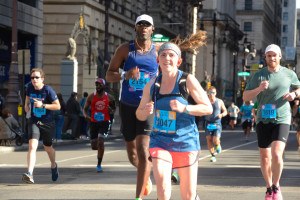How to Train Your Mind to Tackle the Mental Hurdles You’ll Encounter During Broad Street

Photo by G. Widman for Visit Philadelphia
No matter how many miles you log in your Broad Street Run training, there’s no escaping that point in the race where your breathing becomes more difficult, your legs feel heavier, and your ability to keep pace feels, well, completely out of reach. Slowing down seems inevitable — but it doesn’t have to be. What you choose to do in this moment completely within your control.
For most, the goal of training is to develop the cardiovascular and muscular systems in preparation for the physical demands of running. However, runners are much more than lungs, heart and muscles. There’s another system, with perhaps a bigger role, signaling your lungs to contract, your heart to beat and your legs to move: the nervous system.
There has been a recent flood of research on the role of the nervous system in endurance sports. One of the world’s leading sports scientists, Tim Noakes, a professor of exercise and sports science at the University of Cape Town in South Africa, has proposed something he calls the central governor theory. Noakes states that your brain “limits exercise by reducing the neural recruitment of muscle fibers. This reduced recruitment causes the sensation of fatigue.”
Think of your brain as your body’s command center. Once your cardiovascular and muscular systems start approaching their limits, your brain sends signals to start shutting them down. Fatigue will start to set in, forcing you to slow down. In most cases, this “need” to slow down is only a message from your brain, but you’re physically still capable of continuing at or above that pace. It is your body’s defense mechanism, protecting you against potential harm that may occur.
This explains why after running an exhausting race you can find the energy to suddenly sprint across the finish line despite feeling fatigued throughout the entire race.
The key takeaway from Noakes’s research is this: You can use the central governor theory to your benefit. Here are two strategies to assure that your brain is just as ready as your body.
1. Visualization
Visualization is a mental technique used by top athletes across all sports and is proven to be one of most effective mental-performance strategies. It involves creating mental images of desired outcomes before they happen.
For the Broad Street Run, you’ll want to imagine you’re at a particular point feeling good, relaxed and smooth. Imagine during your long runs or hard workouts that you’re in the middle of the race near South Street, just past mile six. Focus on being relaxed, comfortable and fast. Say to your self, “I’ve got this, I feel good.” Practice this technique during all your long runs and hard workouts. The more you practice, the better.
2. Chunking
Chunking is a mental technique that involves breaking a larger task into smaller, more manageable pieces. Runners can use this technique to help deal with the pain of running near their maximum ability for extended periods of time or distance. Break the run, workout or race into smaller more manageable efforts. Ideally, you want to aim for three or four smaller pieces. Then, approach each piece or “chunk” with a different attitude and plan your approach to each piece. Identify which chucks will require the most physical and mental efforts and, therefore, will be the most difficult.
Here’s how to chunk the Broad Street Run. Break it into three chunks: the first five miles, the middle three miles and the last two miles. Now here’s your game plan: The first five miles will be the easiest of the three chunks and will require the least mental and physical effort. Think of it as a fast warm-up and not part of the race. Stay relaxed, comfortable and enjoy the sights.
Now you’re left with two chunks totaling five miles. This is the meat of the race. And, hey, racing five miles sounds a whole lot easier than racing 10 miles, right?
So your race really starts at mile six. Fatigue will start to set in and your pace may begin to slow. This is when you should start tapping into your mental power to avoid slowing. Use visualization to stay relaxed, but fast.
The last two miles will be tougher physically then mentally. At this point, your mind knows the finish is close and will start to lift the breaks. Think of it as a two-mile race now, and give it your all.
Now, here’s the key: You’ll need to practice these techniques ahead of the May 1st race. Use your training runs, long runs and workouts to hone these skills. Visualize yourself at the six-mile marker feeling strong and relaxed. Chunk your long runs into three pieces, tackling each piece with a different game plan.
Running at your limit is a balance between peak athletic fitness and a strong focused mind. On May 1st, when you line up at the starting line, replay in your mind all the long runs, hard runs and workouts you’ve pushed through. Physically, the work is done. Just remember when that cynical voice in your head tells you to ease up (and it will!), don’t listen to it — you still have gas in your tank.
……………
Cory Smith, a Philadelphia based running coach, shares his expert advice as an American Cancer Society DetermiNation running coach; founder of Run Your Personal Best, a private running-coaching business; and head cross country coach at Penn State Brandywine. He is a USA Track and Field-certified coach and a 4:03 miler. As a student athlete at Villanova, Cory was an NCAA Division One Regional and National Championship qualifier. Contact Cory at cory@runyourpersonalbest.com. Read all of Cory’s posts for Be Well Philly here.
Like what you’re reading? Stay in touch with Be Well Philly—here’s how:
- Like Be Well Philly on Facebook
- Follow Be Well Philly on Twitter
- Follow Be Well Philly on Pinterest
- Get the Be Well Philly Newsletter


